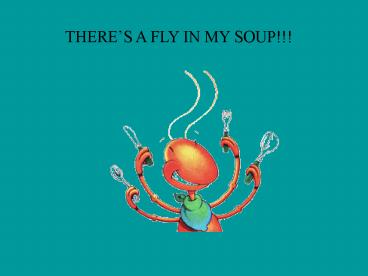THERES A FLY IN MY SOUP - PowerPoint PPT Presentation
1 / 11
Title:
THERES A FLY IN MY SOUP
Description:
Grasshoppers top the list as the insect most eaten by. many Africans and Venezuelans. ... Where are most insects eaten? What is the most popular insect? Grasshopper ... – PowerPoint PPT presentation
Number of Views:33
Avg rating:3.0/5.0
Title: THERES A FLY IN MY SOUP
1
THERES A FLY IN MY SOUP!!!
2
Entomorphagy
The history of people eating bugs.
There is a long history of people eating bugs.
Aristotle and Pliny both wrote about it. The
Bible documents many instances of people eating
bugs. Native Americans of North America ate them.
Today, however, people in North America wont
touch them.
3
WHY EAT INSECTS?
During various periods in history, food was
scarce. Insects were plentiful and they provided
an excellent source of protein.
Algeria - The natives of Algeria would
collect large numbers of desert locusts
to use as food. They were a valuable resource for
the poor population. The locusts were
cooked in salt water and dried in the
sun. Not only were they collected for personal
use, but the locusts were traded in the
markets as well..
4
WE ALL EAT INSECTS
Many foods we eat have insects or insect parts in
them that we don't see. The Department of Health
and Human Services has set a standard called the
Food Defect Action Levels. These levels are set
because it is not possible, and never has been
possible, to grow in open fields, harvest and
process crops that are totally free of natural
defects."
5
How Many Bugs Did You Eat Today?
Product
Action Level
Apple butter
5 insect per 100g
Chocolate 80 microscopic insect fragments
per 100g
Canned mushrooms 20
maggots per 100g
Tomato paste, pizza, and other 30 eggs
per 100g OR sauce.
2 maggot per 100g
Source The Food Defect Action Levels Current
Levels for Natural or Unavoidable Defects for
Human Use that Present No Health Hazard.
Department of Health Human Services 1989.
6
How Do You Want Them Served?
Insects are served in a variety of ways in all
parts of the world. They are often eaten when
they are immature prepared in the following
ways fried, dried, roasted, souped, and floured.
When choosing bugs to eat, you should make sure
that they have not been exposed to pesticides.
Although some cultures eat insects raw, all bugs
should be cooked before eaten. SOME INSECTS
CONTAIN TOXINS!! Usually, bright colored bugs
are more likely to be toxic.
Some common bugs for eating include termites,
ants, crickets, grasshoppers, and caterpillars.
Bees are eaten but they must be boiled first to
neutralize the stinger. Grasshoppers top the
list as the insect most eaten by many Africans
and Venezuelans.
7
Lets Review!
Give examples in history when people ate bugs.
Aristotle and Pliny wrote about eating them.
The Bible documents it many times.
North American Native Americans ate them.
8
Give 2 reasons why people eat insects.
Throughout history when food was scarce insects
were eaten.
Insects provide a good source of protein.
9
We All Eat Insects!
Many foods we eat contain insect parts.
It is impossible to grow and harvest crops
without some insects getting in them.
Therefore, the Food and Drug Administration
allows so many bug parts in our food.
10
How is bug food prepared?
Fried, dried, roasted, and souped.
Although they are eaten raw in many cultures You
should cook them before you eat them.
Why?
Some insects are poisonous.
What bugs should you avoid?
Those that are brightly colored or exposed to
pesticides.
11
Where are most insects eaten?
Africa, Asia, and South America.
What is the most popular insect?
Grasshopper































![[PDF] READ Free A Funny Thing Happened on My Way Through the Bible PowerPoint PPT Presentation](https://s3.amazonaws.com/images.powershow.com/10046137.th0.jpg?_=20240603064)